

19 Short Stories and Questions For Critical Thinking
Apr 2, 2024
There have been rumblings in different online teacher groups recently about replacing novels with short stories and informational articles in middle and high school English classrooms. I have to admit I was shocked when I first read the comments because I am a book lover at heart, but since then, I’ve considered that there are several pros and cons to this approach.
Short stories and other smaller texts can provide a briefer timeline to complete tasks, and this process is helpful when there is already SO MUCH curriculum to cover. Short stories and related activities can also be more engaging for our students because of the exposure to diverse voices and themes! Using short stories and lessons provides students with amazing choices to meet their needs and preferences!
On the other hand, incorporating mainly short stories and other shorter passages means students’ already-pressed attention spans (as a result of social media influences and pervasive sources of technology) are reinforced. Plus, students miss out on the more complex stories within longer pieces of fiction that are, dare I say, life-altering! A novel can provide opportunities for sustained reading and layers for analysis that shorter pieces of literature like short stories and related texts cannot offer.
Ultimately, no matter where you find yourself on the issue, I think we can all agree that short stories and their counterparts can be vital, effective, and helpful in the modern classroom!
Continue reading for 19 Short Stories and Questions For Critical Thinking!!
Need help with Test Prep ? Check out this FREE Pack of 3 Test Prep Activities to help students achieve success on standardized tests!

Table of Contents
19 Short Stories and Questions – Suggestions for Teaching Them
You don’t need to remove all novels to be able to include short stories and smaller passages like vignettes, articles, and narratives; there’s a time and place for all genres! But if you’re thinking about ways to include more short stories and fun activities, check out this list of 19 varied short stories and critical thinking questions as well as suggestions for teaching them in middle school and high school.
1. “The Most Dangerous Game”
“The Most Dangerous Game” is one of my absolute favorite short stories and overall plots to teach! This suspenseful short story by Richard Connell follows the harrowing ordeal of Sanger Rainsford, a skilled hunter who becomes the prey of a deranged aristocrat named General Zaroff. Stranded on Zaroff’s secluded island, Rainsford must outwit the cunning general in a deadly game of survival, where the stakes are life and death.
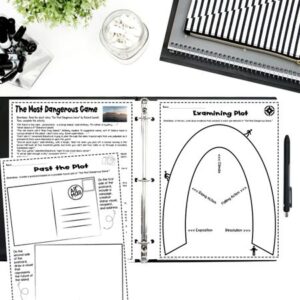
SUGGESTIONS FOR TEACHING:
- You could focus on the setting (description of time and place) and examine how the setting changes throughout the story.
- Students could learn about the plot (major events in the story) and list the major events and evidence as they read.
- Define foreshadowing (hints for what will happen by the end of the story) and encourage students to hypothesize about what will happen after every page.
- Analyze the character development (how a character changes over time) of Rainsford and highlight his traits/actions as you read along.
CRITICAL THINKING QUESTIONS:
- How does the setting contribute to the tension and suspense in the story?
- How does the author use foreshadowing? How does the author hint at the danger Rainford is facing?
- What inferences can you make about the main character and the changes he undergoes from the beginning to the end of the story?
If you want to teach plot elements and plot analysis , check out this lesson bundle for the story , which includes comprehension quizzes and a variety of activities!
2. “An Occurrence at Owl Creek Bridge”
Ambrose Bierce’s story is a gripping tale set during the American Civil War, where a Southern civilian named Peyton Farquhar faces execution by hanging after attempting to sabotage a Union railroad bridge. As Farquhar falls through the trapdoor, time seems to stretch, and he experiences a surreal moment, only to realize his grim reality.
Integrating historical texts with other short stories and passages like “An Occurrence at Owl Creek Bridge” will make history come more alive and relevant for our students!
- Teach about irony (when the opposite occurs from what is expected) and how it plays a role throughout the story.
- Explain the term characterization (how a character is depicted) by looking at direct and indirect references while reading with your students.
- Discuss the major themes (messages) of the story and how they connect to our modern era within a Socratic Seminar.
- How does the author use characterization to convey Peyton Farquhar’s thoughts, emotions, and motivations?
- What is the purpose of irony in this story? How does its use affect the reader’s interpretation and understanding of events?
- What is the significance in our contemporary/real world of the themes of the story, including reality and fantasy, the passage of time, and the consequences of actions?
Ensure students’ understanding of the story with this set of reading questions that are perfect for state test prep, too !
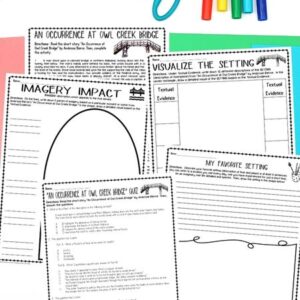
3. “The Masque of the Red Death”
This chilling tale from Edgar Allan Poe is set in a secluded abbey where Prince Prospero and his wealthy guests attempt to escape a deadly plague known as the Red Death. Despite their isolation efforts, the guests are confronted with their own mortality as a mysterious figure in a blood-red mask appears.
If you have not read any short stories and poems from Poe, this story is a perfect journey into the horror genre!
- The setting (description of time and place) plays a MAJOR role in the story, so following the Prince from room to room and highlighting the imagery (description that connects to the five senses) is very important when reading.
- If you have not introduced mood (emotion intended for the reader to experience), this story is PERFECT for delineating its progression from start to finish.
- As students read, you might guide them through identifying various examples of symbolism (object, person, or place that represents something else); each room, objects within, and the “antagonist” is symbolic in some way!
- How does the author convey the tone of the story? How would you, as the reader, describe the story’s mood?
- What role does the plot structure (focus on the different rooms) play in shaping the reader’s understanding of the story?
- What is the purpose of the symbolism in the story such as the clock and the masked figure?
Check out this EASY-TO-TEACH bundle , you can practice with your students, so they will feel more confident analyzing higher-level language in “The Masque of the Red Death!”
4. “The Cask of Amontillado”
Another chilling tale from Poe is the classic story “The Cask of Amontillado.” This one is set during Carnival in an unnamed Italian city. The plot centers on a man seeking revenge on a ‘friend’ he believes has insulted him. If your students are anything like mine, they will relish the ending particularly!
This is just one more of Poe’s short stories and tales that will capture the mind of every reader!
- As you plan for this short story, be sure to encourage your students to analyze the changing setting (description of time and place); following Fortunato from scene to scene will help your students track what is really going on.
- This story is the perfect moment to teach about dialogue (conversation within someone=internal and/or between someone and someone/thing else=external); Montresor certainly means more than what he SEEMS to say!
- You might also offer a mini-lesson on the 3 types of irony and how each plays a role in the story: verbal (when a person says the opposite of what is really intended), situational (an action occurs that is the opposite from what the reader expects), and dramatic (a character expects a result, but the opposite occurs and the audience can tell what will happen)!
- Describe Montresor. What are his motives and personality?
- What inferences can you make about Montresor’s mindset based on his dialogue?
- What is the purpose of the family’s motto and the carnival atmosphere?
Check out this Short Story Activity & Quiz Bundle for Edgar Allan Poe’s “The Cask of Amontillado,” which contains questions and answers modeled after various reading standardized tests as well as pre-quiz reading comprehension questions, graphic organizers, and a writing activity to get students thinking critically about this classic short story involving REVENGE!
Want 7 more teaching ideas for one of Poe’s epic short stories and questions to go with it? Click below!
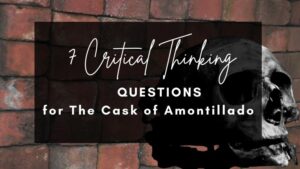
5. “To Build a Fire”
This story by Jack London describes the treacherous journey of a man through the harsh Yukon wilderness during extreme cold. Despite warnings and the company of a loyal dog, the man’s arrogance and underestimation of nature’s power lead to a tragic end.
Short stories and ideas related to survival in nature are still relevant today! Who knows when you might get lost on a hike or crashland in no man’s land?
- This story is PERFECT for a bit of literary analysis (examining the impact of various ideas, elements, or themes within a piece of literature); you could hone in on literary devices, characterization, theme, etc.!
- Integrating clips from survival shows will help students see connections to the world and extend their thinking by comparing (recognizing similarities) and contrasting (recognizing differences) varied experiences!
- Write a short narrative about surviving 24 hours in a different setting (description of time and place).
- How does the author use irony? Provide an example and explain.
- What real-world connections can be made between this story and our contemporary life?
- What is the story’s message about preparedness and respecting nature?
Grab these engaging short stories and activities to make teaching this Jack London story stress-free!
6. “The Cactus”
Told from the point of view of a young man at his former lover’s wedding, the narrator retells their story. Like most of O. Henry’s short stories and texts, this one has a twist that involves the titular cactus plant.
The ending will end in a bit of fun for your students!
- Introduce diction (word choice) and its impact within the story by hyperfocusing on specific words within the story . Students can look up definitions, locate synonyms, create their own sentences, replace the words, etc.
- Investigate twist endings (unexpected finish to a story); before reading the end of the story, ask students to guess why the girl “rejected” him. Some students may know the answer before reading it!
- Describe the main characters. What similarities and differences are evident? How does this affect the story’s action?
- What inferences can you make about Trysdale and his feelings about love and marriage?
- What are the real and symbolic meanings of the cactus?
This resource packed with questions and answers, graphic organizers, and writing activities is sure to get your students thinking about this love story driven by misconceptions.
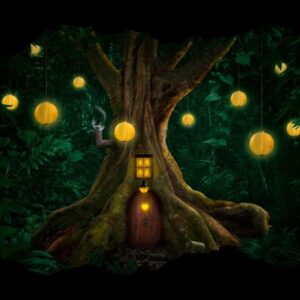
7. “After Twenty Years”
This tale of friendship and betrayal focuses on the reunion of two old friends after twenty years apart on a New York City street corner. As they reminisce, something is revealed that demonstrates the reality of their bond as well as the choices they’ve made in life.
If you have not read O. Henry’s short stories and incorporated character analysis yet, this is your chance! The story is not long and can be completed in one to two class periods!
- Sometimes, we ask students to visualize (create a picture) in their minds, but why not give them the opportunity to use their artistic skills to draw the two characters?
- As students read, annotate for a description of each character; then, students can do a character analysis (investigation of the characters’ similarities and differences).
- What type of irony is used in the story? How does its use affect your interpretation and understanding of the story?
- How does the urban setting contribute to the mood of the story?
- What is the story’s message about friendship and loyalty?
Examine the links between loyalty and duty with this set of resources designed specifically for this O. Henry story.
8. “The Lottery”
“The Lottery” is the quintessential short story for middle school or high school English! Shirley Jackson’s “The Lottery” tells the story of an annual ritual that takes place in a seemingly idyllic town. When the townsfolk gather for the lottery drawing, a shocking turn of events demonstrates the dark side of human nature and their ties to (outdated) traditions.
- Introduce the terms suspense (uncertainty and/or excitement leading up to a major event) and tension (anxiety or uneasy feelings experienced by characters). While reading, identify evidence that relates to each of these concepts and chat/write about their impact on meaning and plot.
- Teach title (the name of the text) analysis. The title of “The Lottery” is perfect for teaching the impact of the title and audience expectations. Before reading, students may write what they believe the story will be about based on the title. After reading, students can complete a quick write responding to their previous expectations! You can do a text analysis for all short stories and poems!
- What role does the plot structure play in building suspense and tension? (Consider the revelation of the lottery’s ‘prize’ in particular.)
- What social commentary is being made through the story and its characters?
- Describe Mr. Summers, Tessie, and Old Man Warner. What does the story reveal about their role in the community and their feelings about the lottery?
Give yours elf a breath of fresh air with this NO PREP curriculum that integrates test prep within the teaching of literature by using Shirley Jackson’s quintessential story!
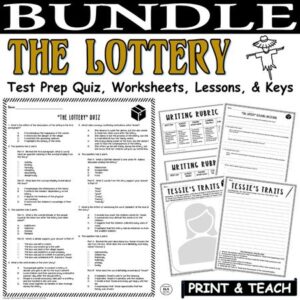
9. “The Pedestrian”
This Ray Bradbury story follows a lone walker in a futuristic society in which everyone else is consumed by technology, particularly the television. One evening, the walker encounters a police car that questions his unusual behavior and the end is quite unexpected! (Most of Bradbury’s short stories and texts connect to the future and technology in some way!)
- This story exemplifies Dystopian Literature (texts that include a supposedly perfect future society marred in some way by governmental or societal oppression). Using this story to introduce this type of literature is always fun for students because they will easily make connections to other dystopic short stories and poems!
- Teach about mood (the emotional impact of a story’s description/action). The goal is to get students to deepen their critical thinking skills by recognizing how the mood changes and the purpose for that change!
- How does the author use foreshadowing and suspense to build the mood of the story?
- What is the central theme of the story? How might it connect with our current world?
- What similes and metaphors does Bradbury use to describe the community and its members? What is notable about these comparisons?
With this resource about Bradbury’s “The Pedestrian,” you can just print and teach the lesson and activities with EASE!
10. “The Gift of the Magi”
This 1905 story by O. Henry relays a tale about a couple struggling to make ends meet. Throughout the story, they both figure out gifts to buy one another for Christmas and realize what love truly means!
- Review character traits (how a character is depicted internally and externally). Log the traits of each character within the story and how they are important to the meaning of the story.
- Extend (move beyond the text) critical thinking skills by encouraging students to think and write about other people. If they had $1,000 to spend on someone else, how would they spend the money and why?
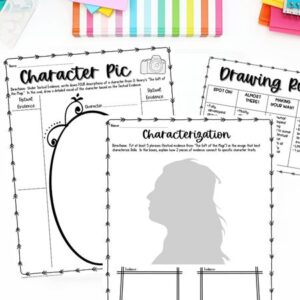
- How would you describe Della and Jim, and their relationship?
- What values do the characters have, when you consider their actions and decisions?
- Explain how dramatic irony is used in the story. Is it necessary? Is it effective? Why or why not?
This tale is a great addition to your short stories and questions unit around the winter holidays! Save yourself time at that time of the year with this lesson bundle .
11. “The Monkey’s Paw”
“The Monkey’s Paw” is a classic horror story about the White family who come into possession of a mystical monkey’s paw that grants three wishes. Despite warnings, they use it and then face devastating consequences as a result.
- Teach about the elements of the horror/suspense genre (Ex. Scary movies are typically dark, stormy, surprising, morbid, etc.).
- Create a thematic statement (message relayed by the text in a complete sentence). There is no perfectly created theme (message) unless it is directly stated by the author; however, students can create a theme by supporting their ideas with evidence from the story!
- What is the main theme of the story? Or how does the author communicate the themes of greed or fate? Is one stronger than the other?
- Are Mr. and Mrs. White more alike or different from one another? How do you know?
- Should we be afraid of the unknown? What message does the story share? Do you agree or disagree?
Examine W.W. Jacobs’ classic story with this set of questions and answers along with rigorous reading and writing activities . While it is ideal for a spooky season, the story is valuable for its ability to hook readers any time of year!
12. “Lamb to the Slaughter”
This classic story with a killer plot twist is about a woman who kills her husband and gets away with murder thanks to cooking a leg of lamb!
- You could introduce the plot elements (exposition, rising action, climax, falling action, resolution), encourage students to identify major events to fit each element and write down textual evidence to support their ideas.
- Complete a film analysis (examination of film techniques and their effects) to compare/contrast the short story with the classic Alfred Hitchcock television episode.
- What is Mary Maloney’s state of mind? Does it remain the same or does it change throughout the story? Explain.
- Is the resolution of the story satisfying? Why or why not? Why do you think the author ended it as he did?
- How does irony contribute to the theme of deception in the story? Explain.
Spice up your middle school English or high school English class with this short stories and activities bundle for Dahl’s famous story!
13. “The Tell-Tale Heart”
Poe’s classic psychological thriller is narrated by an unnamed protagonist who insists on their sanity while recounting how they murdered an old man. The narrator is haunted by the sound of the victim’s beating heart, which ultimately drives him to confess to the crime despite not originally being a suspect.
- Teach symbolism (object, person, or place that represents something else) by focusing on the heart and eye . The author used these symbols in various ways!
- Investigate psychology (the study of the human mind) as a part of the story. Determine what is fact and what is fiction within the narrator’s mind.
- What does the story reveal about the human psyche?
- What is the deeper meaning of the two key symbols in the story – the beating heart and the eye of the old man?
- What role do the narrator’s inner thoughts play in the development of the plot?
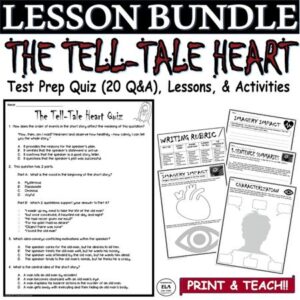
This Short Story Comprehension Bundle offers quick (and effective!) ways to assess students’ learning and understanding of the story. It’s easy to use and will no doubt save you time too!
14. “The Scarlet Ibis”
Emotional short stories and their counterparts have a place as well in English classrooms! This short story by James Hurst about two brothers is a heartbreaking must-read. Through flashbacks, the unnamed narrator tells the life story of his younger sickly brother William Armstrong, who is nicknamed Doodle. And the end…well, you’ll see.
- Define and explain the purpose of a flashback (referring back to the past within a story). Think about the implications of never thinking back on the past or always thinking about the past.
- Complete a comparison chart between Doodle and the Ibis as you read along. Then, students can create a visual of each after they have ready by using their own evidence!
- What is the meaning of the story’s title and the presence of a scarlet ibis in the story?
- What is the central theme of the story? How do the events of the story support this chosen theme?
- How does the author use personification for the storm? What effect does this have on the story?
This flexible resource features critical thinking questions and answers as well as writing and reading activities for students to explore Hurst’s heartbreaking story.
15. “The Veldt”
This science fiction story by Ray Bradbury was first published as “The World the Children Made” and it is quite fitting as a title! The story focuses on a futuristic world in which a video screen can be controlled and it turns out to be more than simple virtual reality! By the story’s conclusion, the world the children made is the downfall of their parents.
- Compare and contrast “The Veldt” with “The Pedestrian,” two short stories and dystopic texts by Ray Bradbury. Analyze the similarities and differences of both short stories and create a thematic statement that connects to both texts!
- Make connections to our current reality in the 21st century. Locate research about the implications of technology on young people and integrate this information as you discuss this short story.
- How does the author address the theme of technology versus humanity in the story? Do you agree with this commentary? Why or why not?
- How does the nursery reflect the personalities of Wendy and Peter in this story?
- Do you know the story of Peter Pan and his friend Wendy? What connections can you make between it and this story by Ray Bradbury?
Ray Bradbury’s classic short stories and similar passages are the BEST to teach in middle and high school English! With so much to dive into, they are sure to be a hit with your students. Grab this set of activities to extend your students’ engagement with rigorous reading and writing activities about “The Veldt.”
16. “The Necklace”
A woman who longs for a life of luxury and elegance beyond her means faces consequences when she loses a borrowed necklace. Guy de Maupassant’s story ends with a twist that has the reader question the value of material possessions.
- I love comparing this short story with O. Henry’s “The Gift of the Magi.” You might choose to focus on the theme, characterization, setting, etc.
- Summarize (writing about the main idea with details) each chunk of the story as you read with your students. Instead of asking students to write a paragraph, you could ask students to create each summary in only one sentence.
- The story explores vanity, deception, and the consequences of striving for social status. Which theme do you think is the most important? Explain with support from the story.
- Is Mathilde Loisel a likable character? Does this change during the story? Does it matter if the reader likes her? Why or why not?
- What clues does the author provide throughout the story that foreshadow the twist at the story’s end?
Focus on the standards with this Short Story Lesson Bundle for “The Necklace” by Guy de Maupassant!
Need help with implementing activities for “The Necklace?” See below!
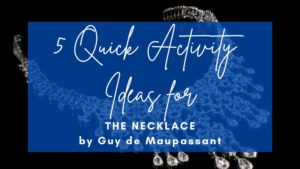
17. “A Vendetta”
Guy de Maupassant’s late-19th-century story is all about REVENGE. A mother is obsessed with creating a plan to avenge her son’s murder and she then puts the plan into action with a morbid outcome.
- There are so many texts that involve REVENGE! Why not use this concept as a focus for a thematic unit (texts linked to a similar concept and/or message)? You could read “A Poison Tree,” “The Cask of Amontillado,” and “Lamb to the Slaughter” as well as “A Vendetta” with the intention of writing about all 4 for a comparison/contrast paper, presentation, or seminar.
- Analyze the development (how a character changes over time) of the mother and the dog throughout the story; you might annotate for similarities and differences as well as their motivations!
- What comment is the story making about the nature (or need) for justice? Do you agree or disagree? Why or why not?
- What similes and metaphors does the author use to communicate the main character’s feelings about the vendetta?
- How does the author use details to explain the main character’s thoughts, feelings, and motivation?
Add these activities for this lesser-known work to your short story plans. It’s sure to keep things fresh for your short stories and activities unit!
18. “Thank You, Ma’am” (also known as “Thank You, M’am”)
This heartfelt story by Langston Hughes tells the story of Luella, an older woman in the neighborhood, who is nearly robbed by a young man named Roger. In response to Roger, Luella brings him back to her home and treats him with an abundance of kindness, which has a profound effect on Roger.
This tale is at the top of the list for the BEST short stories and passages for upper middle and younger high school students!
- Introduce perspective and/or point of view (how a story is told: 1st, 2nd, 3rd omniscient, 3rd limited, 3rd objective). Students might rewrite the story from another perspective or extend the story using the perspective of one of the main characters.
- Review plot elements with a focus on the exposition (introduction to the characters, setting, and conflict), climax (highest point of interest/turning point of the story), and resolution (how the story is concluded and/or resolved in some way.) You could assign an activity surrounding each concept: visualization of the scene, a journal response to the event, or a short response focused on how the element is important to the overall theme!
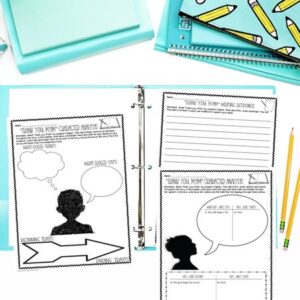
- Do you believe in second chances? What does the story say about second chances?
- How might the climax of the story also be seen as the turning point in Roger’s life?
- How would you describe Mrs. Luella Bates Washington Jones? Are her actions expected or unexpected in the story? Consider from Roger’s and the reader’s point of view.
Click to check out all of the details for this BUNDLE with differentiated options , which includes a Test Prep Quiz (with varied options), Venn Diagrams, Graphic Organizers, and Writing Responses!!
19. “Click Clack the Rattle Bag”
This short story by Neil Gaiman is creepy and fun in the best ways possible! The narrator is taking care of his girlfriend’s little brother and walking him to bed when the child asks for a story. Instead of the narrator sharing a story, the boy shares about the Click Clacks who drink their prey and leave behind rattling bodies. The end is too good to be missed!
Short stories and plots like those in “Click Clack the Rattle Bag” will most certainly engage even your most struggling learners!
- We all know that test prep can be tough as many reading passages are, well, boring! Why not accomplish some test prep with your students and incorporate 5 standardized test-related questions ? You could focus on theme, structure, order of events, characterization, etc.!
- Help students make inferences (acknowledging and hypothesizing about the impact of details that are not directly referenced or stated) as the scene moves along. Students can analyze the change in the setting, the little boy himself, the story the boy is telling, and specific phrases from the story.
- What details in the story contribute to its eerie atmosphere or mood? Or what figurative language devices does Neil Gaiman use to create a sense of suspense in the story?
- How does the author use ambiguity in the story? Is it effective or not? Explain.
- What inferences can you make about the relationship between the narrator and the young boy?
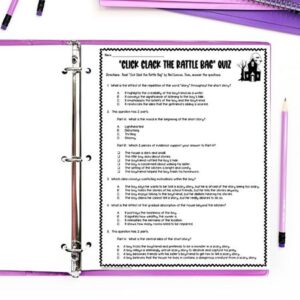
This “Click Clack the Rattle Bag” Quiz Pack for middle and high school students uses the Common Core standards and contains questions and answers modeled after various state standardized tests! Make teaching this amazing short story by Neil Gaiman SIMPLE & EASY!
Why should we incorporate more short stories and activities in our teaching?
While I would never advocate replacing all novels with short stories and smaller texts, there is still something to be said about spending quality time with short stories and excerpts.
Including short stories and standards-based activities is an ideal option to improve reading comprehension and develop skills, especially in middle and high school English classes!
SHORT STORIES AND ACTIVITIES RESOURCES:
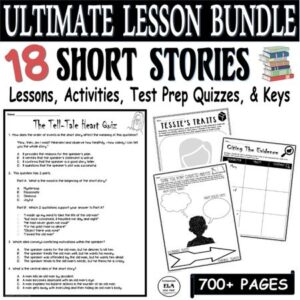
This Short Stories and Test Prep Questions ULTIMATE BUNDLE with Lessons, Quizzes, and Activities uses the Common Core standards with reading comprehension QUESTIONS and ANSWERS for 18 short stories such as “The Most Dangerous Game,” “The Monkey’s Paw,” “The Tell-Tale Heart,” “After Twenty Years,” “The Gift of the Magi,” “The Veldt,” “The Lottery,” “The Pedestrian,” etc. modeled after various state reading exams.
Make teaching short stories and activities SIMPLE & EASY!
Just PRINT & TEACH with engaging short stories and lessons!!
Need more fun ideas for teaching short stories and corresponding activities? Check out my store Kristin Menke-Integrated ELA Test Prep !

Hi, I’m KRISTIN!
I primarily focus on integrating multiple disciplines and subjects. The goal is to make teaching simplified and effective!
Let's Connect
- Follow Follow
Click below to download “13 Simple Strategies to make test prep a breeze!”
- Grades 6-12
- School Leaders
Have You Seen Our List of Favorite Graphic Novels?
100+ Critical Thinking Questions for Students To Ask About Anything
Critical thinkers question everything.
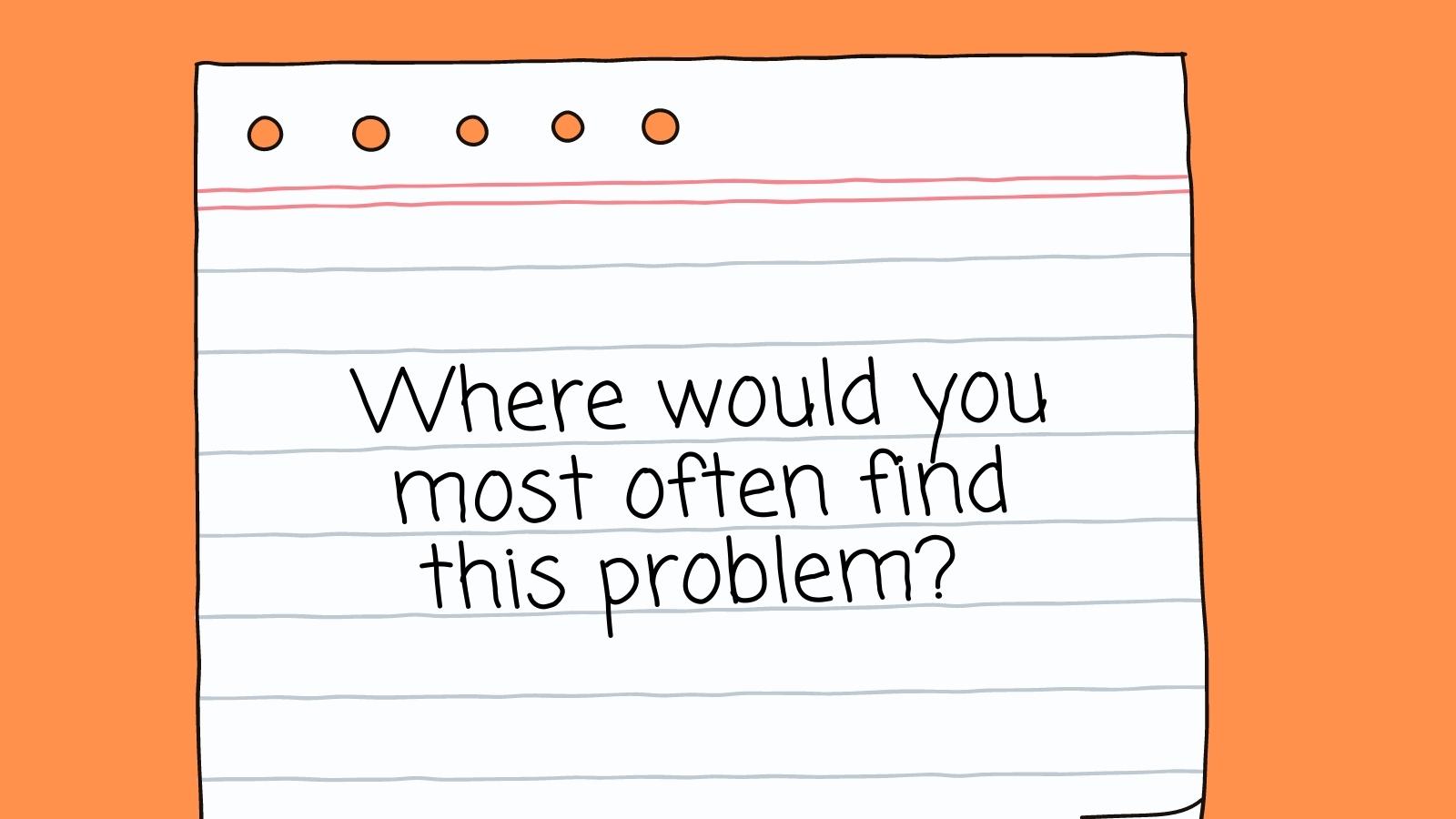
In an age of “fake news” claims and constant argument about pretty much any issue, critical thinking skills are key. Teach your students that it’s vital to ask questions about everything, but that it’s also important to ask the right sorts of questions. Students can use these critical thinking questions with fiction or nonfiction texts. They’re also useful when discussing important issues or trying to understand others’ motivations in general.
“Who” Critical Thinking Questions
Questions like these help students ponder who’s involved in a story and how the actions affect them. They’ll also consider who’s telling the tale and how reliable that narrator might be.
- Is the protagonist?
- Is the antagonist?
- Caused harm?
- Is harmed as a result?
- Was the most important character?
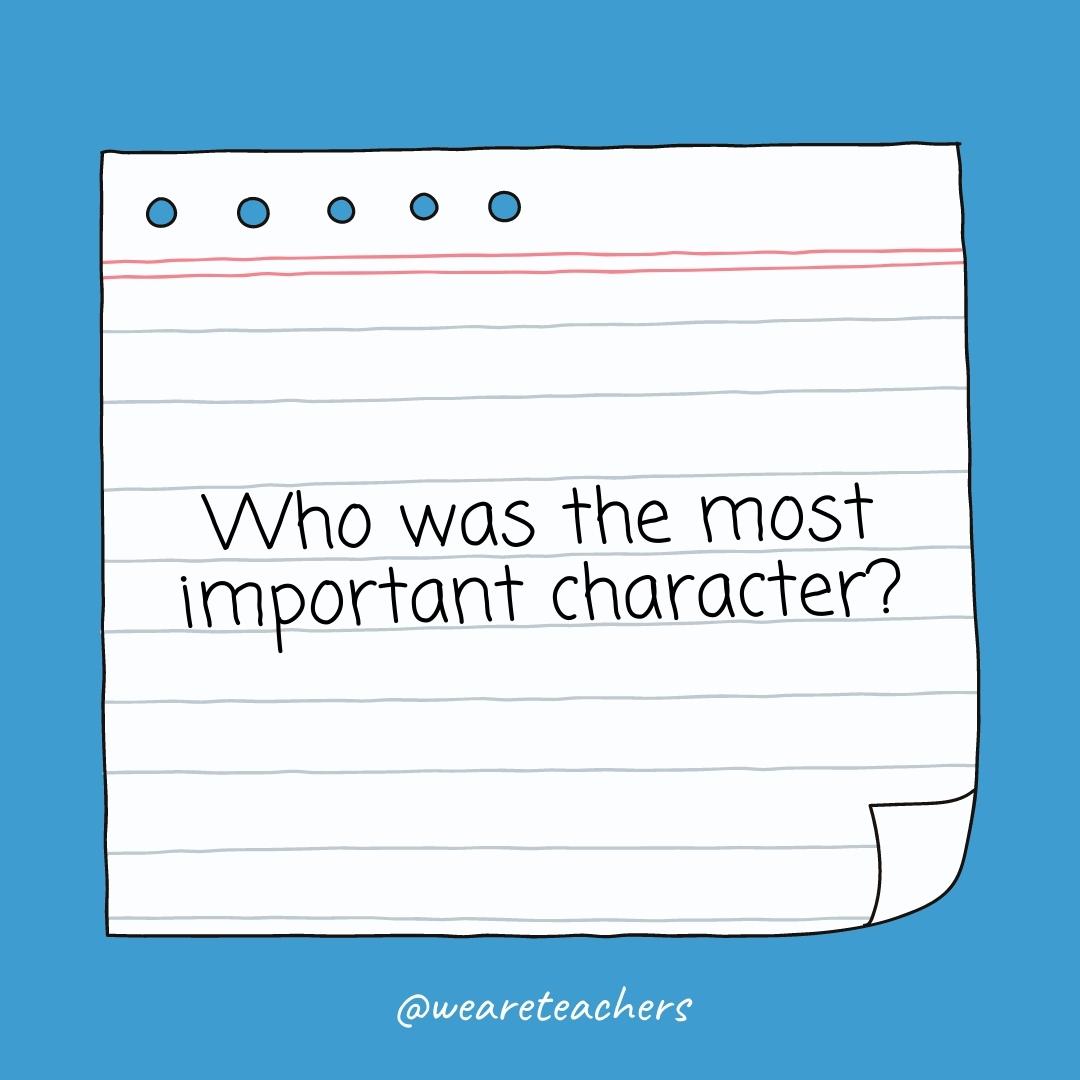
- Is responsible?
- Is most directly affected?
- Should have won?
- Will benefit?
- Would be affected by this?
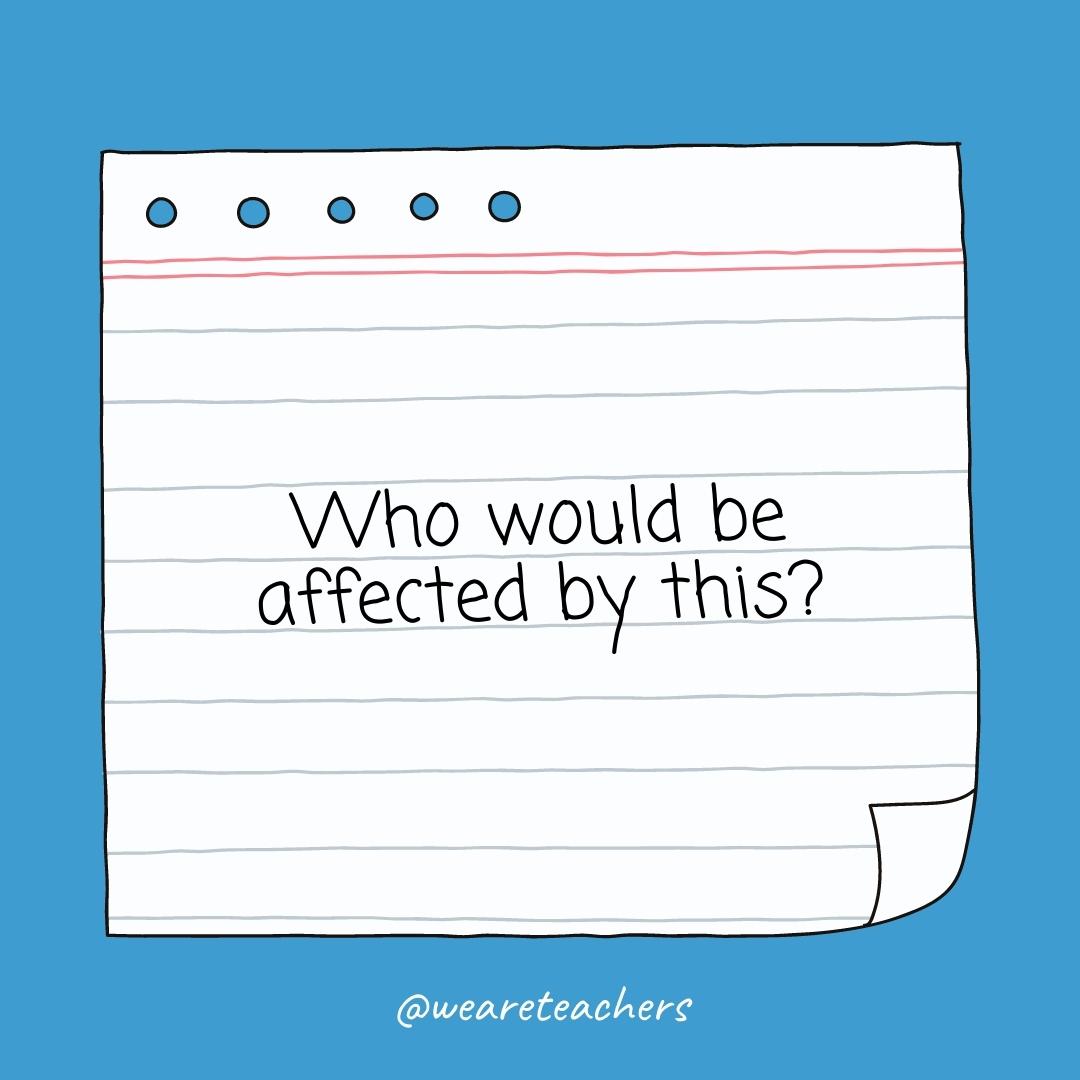
- Makes the decisions?
“What” Critical Thinking Questions
Ask questions that explore issues more deeply, including those that might not be directly answered in the text.
- Background information do I know or need to know?
- Is the main message?
- Are the defining characteristics?
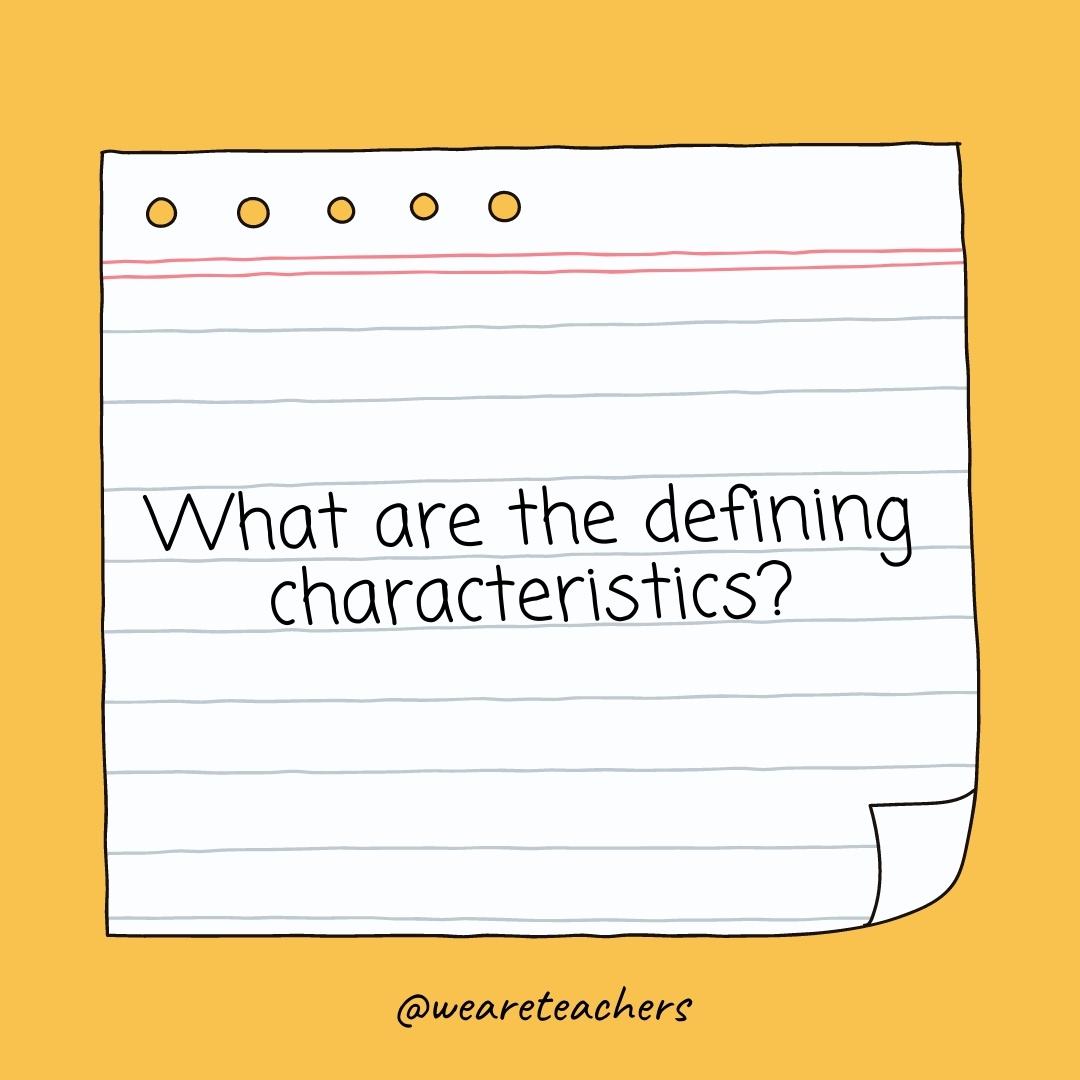
- Questions or concerns do I have?
- Don’t I understand?
- Evidence supports the author’s conclusion?
- Would it be like if … ?
- Could happen if … ?
- Other outcomes might have happened?
- Questions would you have asked?
- Would you ask the author about … ?
- Was the point of … ?
- Should have happened instead?
- Is that character’s motive?
- Else could have changed the whole story?
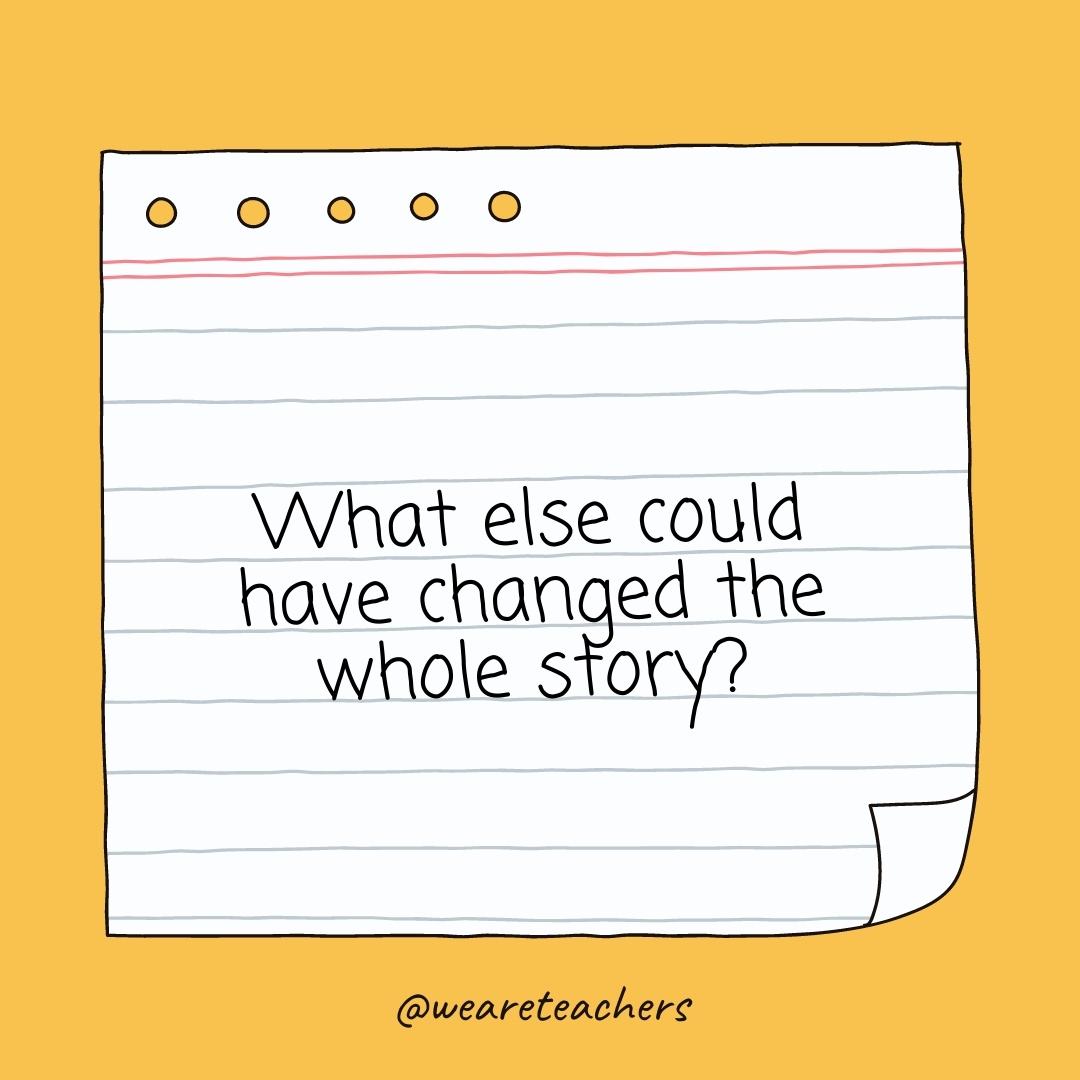
- Can you conclude?
- Would your position have been in that situation?
- Would happen if … ?
- Makes your position stronger?
- Was the turning point?
- Is the point of the question?
- Did it mean when … ?
- Is the other side of this argument?
- Was the purpose of … ?
- Does ______ mean?
- Is the problem you are trying to solve?
- Does the evidence say?
- Assumptions are you making?
- Is a better alternative?
- Are the strengths of the argument?
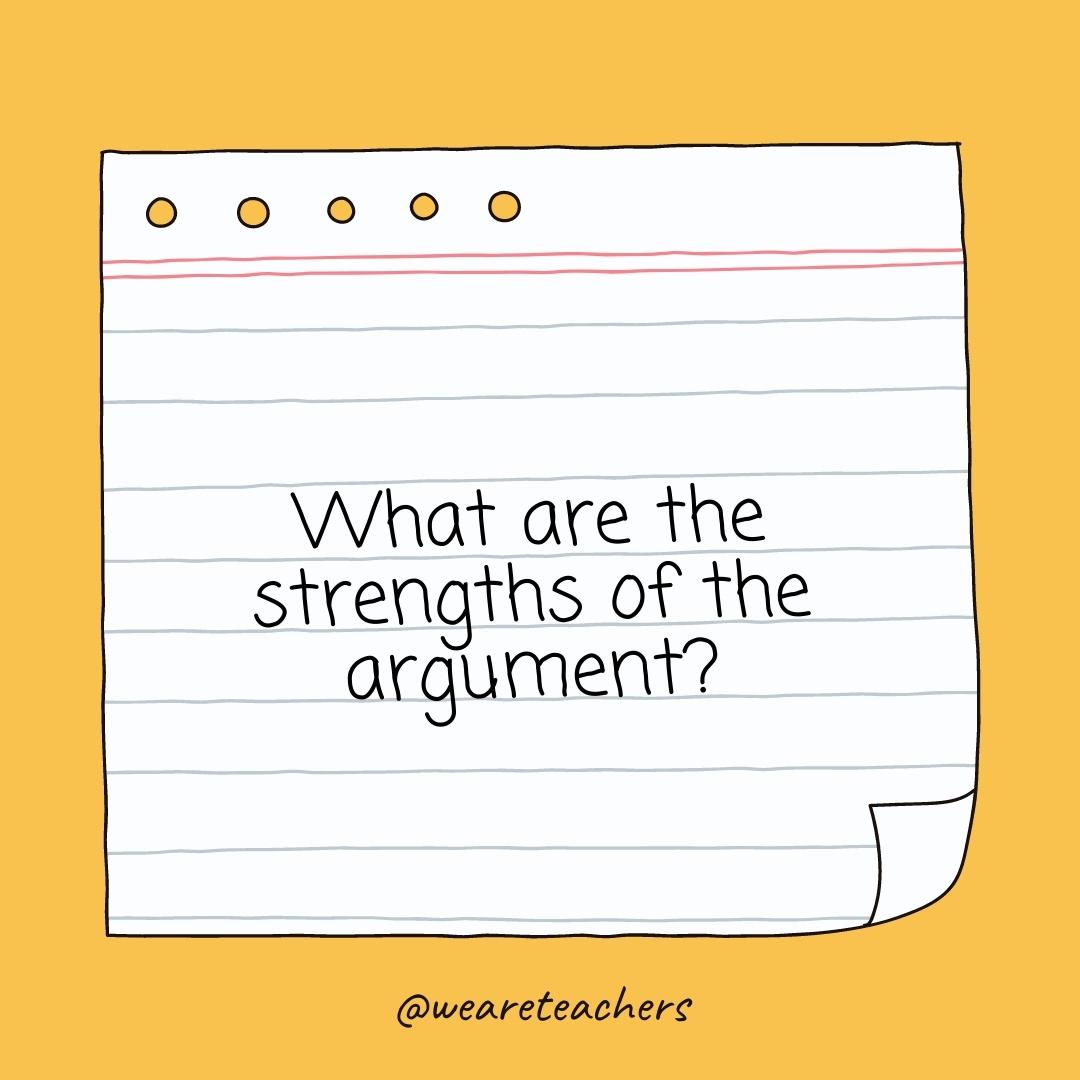
- Are the weaknesses of the argument?
- Is the difference between _______ and _______?

“Where” Critical Thinking Questions
Think about where the story is set and how it affects the actions. Plus, consider where and how you can learn more.
- Would this issue be a major problem?
- Are areas for improvement?
- Did the story change?
- Would you most often find this problem?

- Are there similar situations?
- Would you go to get answers to this problem?
- Can this be improved?
- Can you get more information?
- Will this idea take us?
“When” Critical Thinking Questions
Think about timing and the effect it has on the characters or people involved.
- Is this acceptable?
- Is this unacceptable?
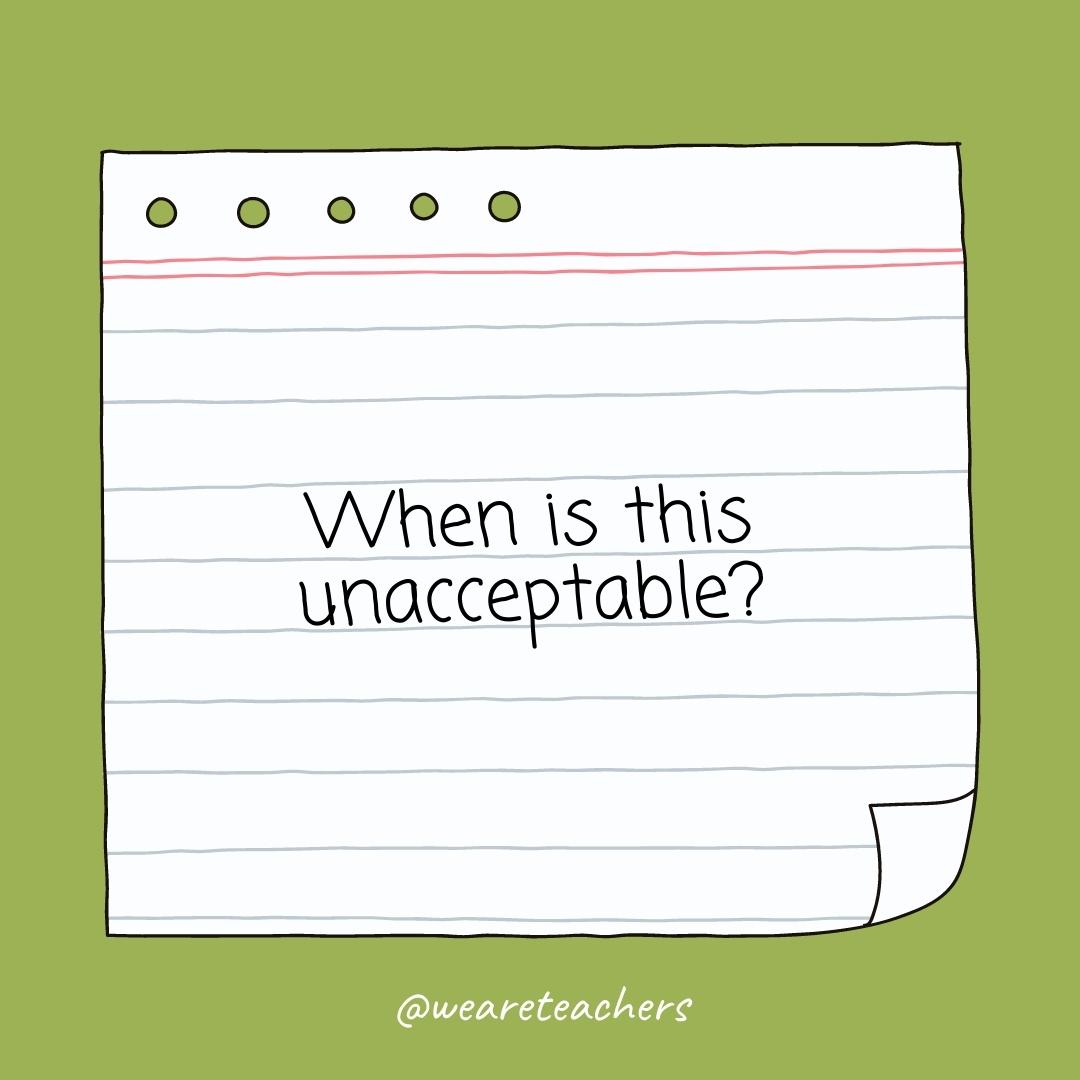
- Does this become a problem?
- Is the best time to take action?
- Will we be able to tell if it worked?
- Is it time to reassess?
- Should we ask for help?
- Is the best time to start?
- Is it time to stop?
- Would this benefit society?
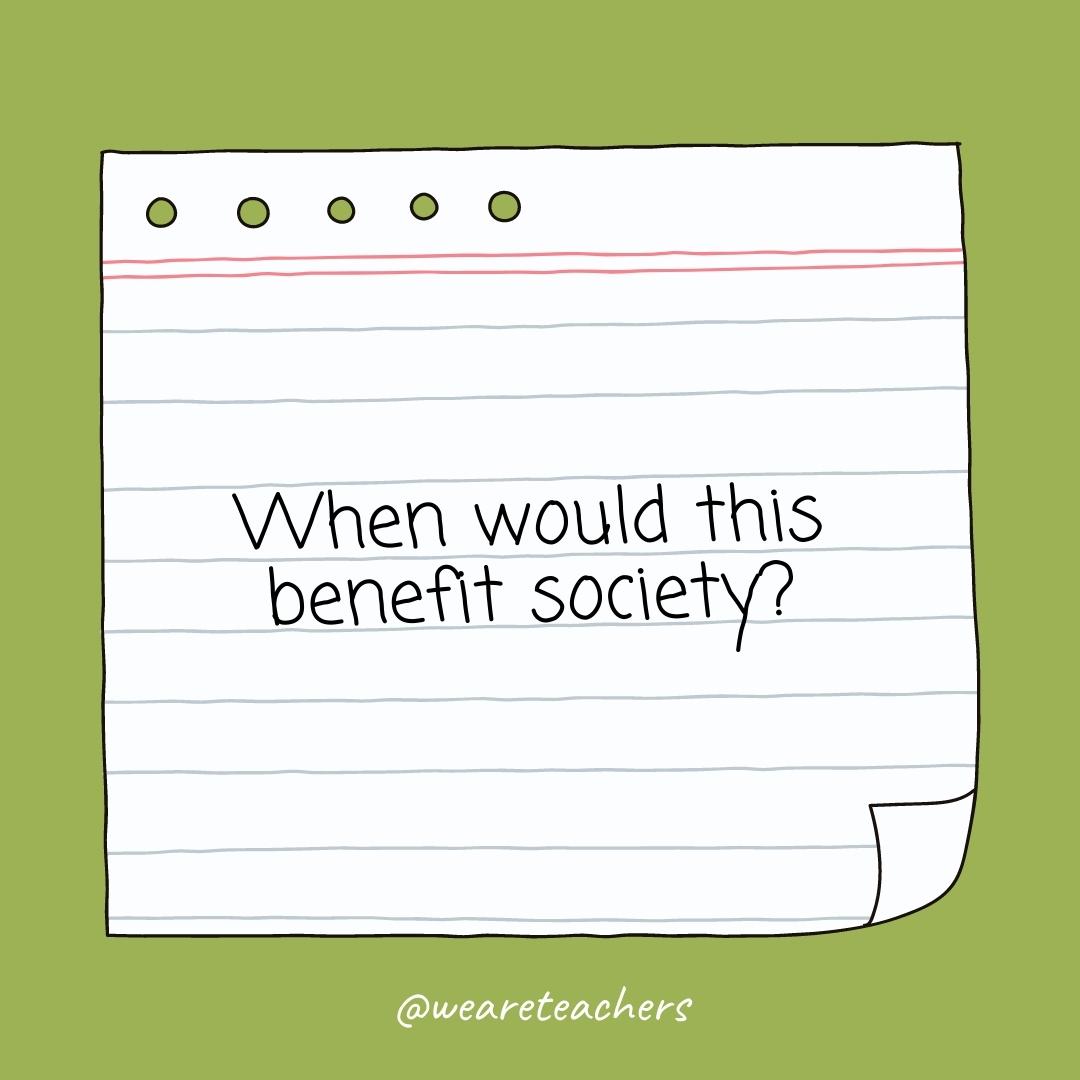
- Has this happened before?
“Why” Critical Thinking Questions
Asking “why” might be one of the most important parts of critical thinking. Exploring and understanding motivation helps develop empathy and make sense of difficult situations.
- Is _________ happening?
- Have we allowed this to happen?
- Should people care about this issue?
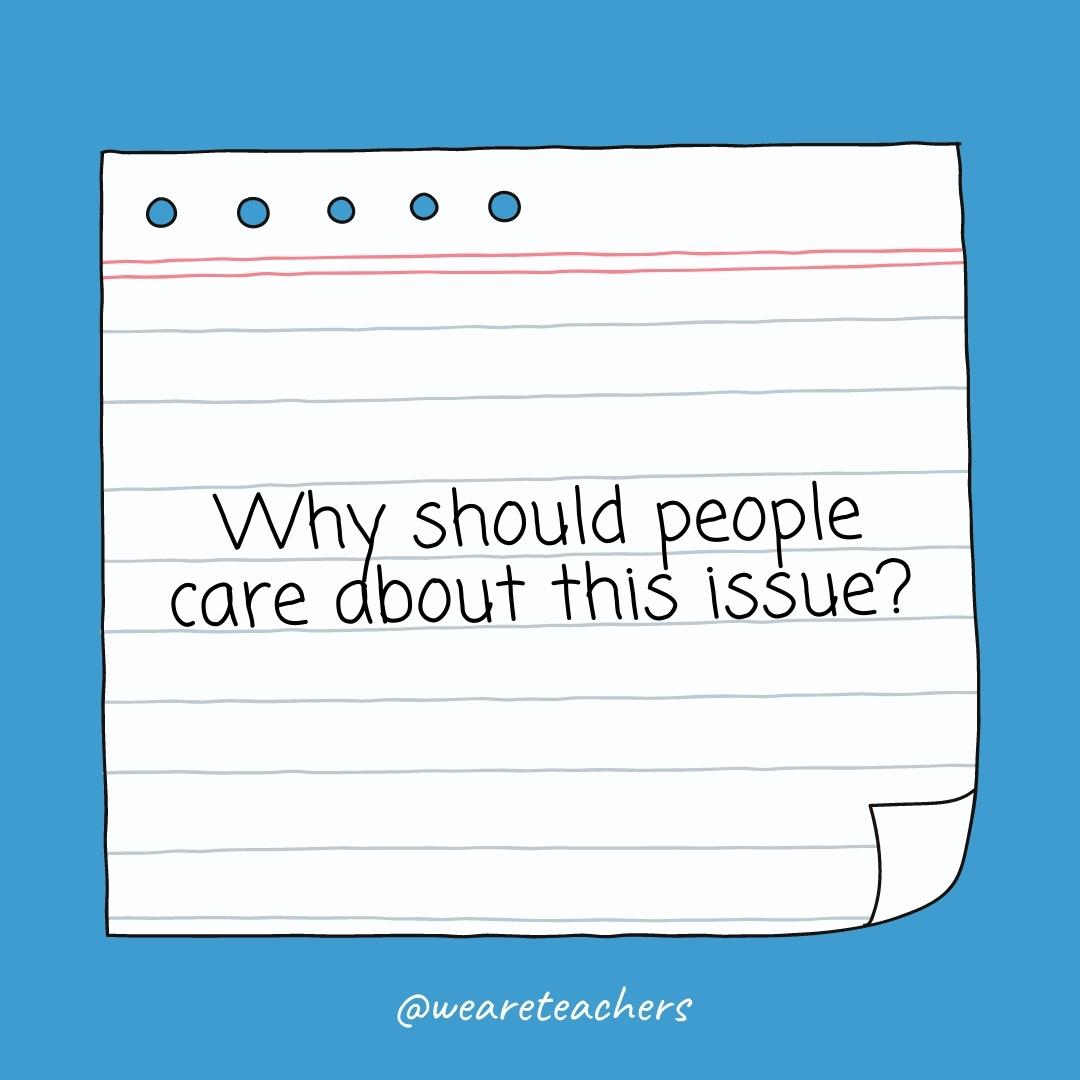
- Is this a problem?
- Did the character say … ?
- Did the character do … ?
- Is this relevant?
- Did the author write this?
- Did the author decide to … ?
- Is this important?
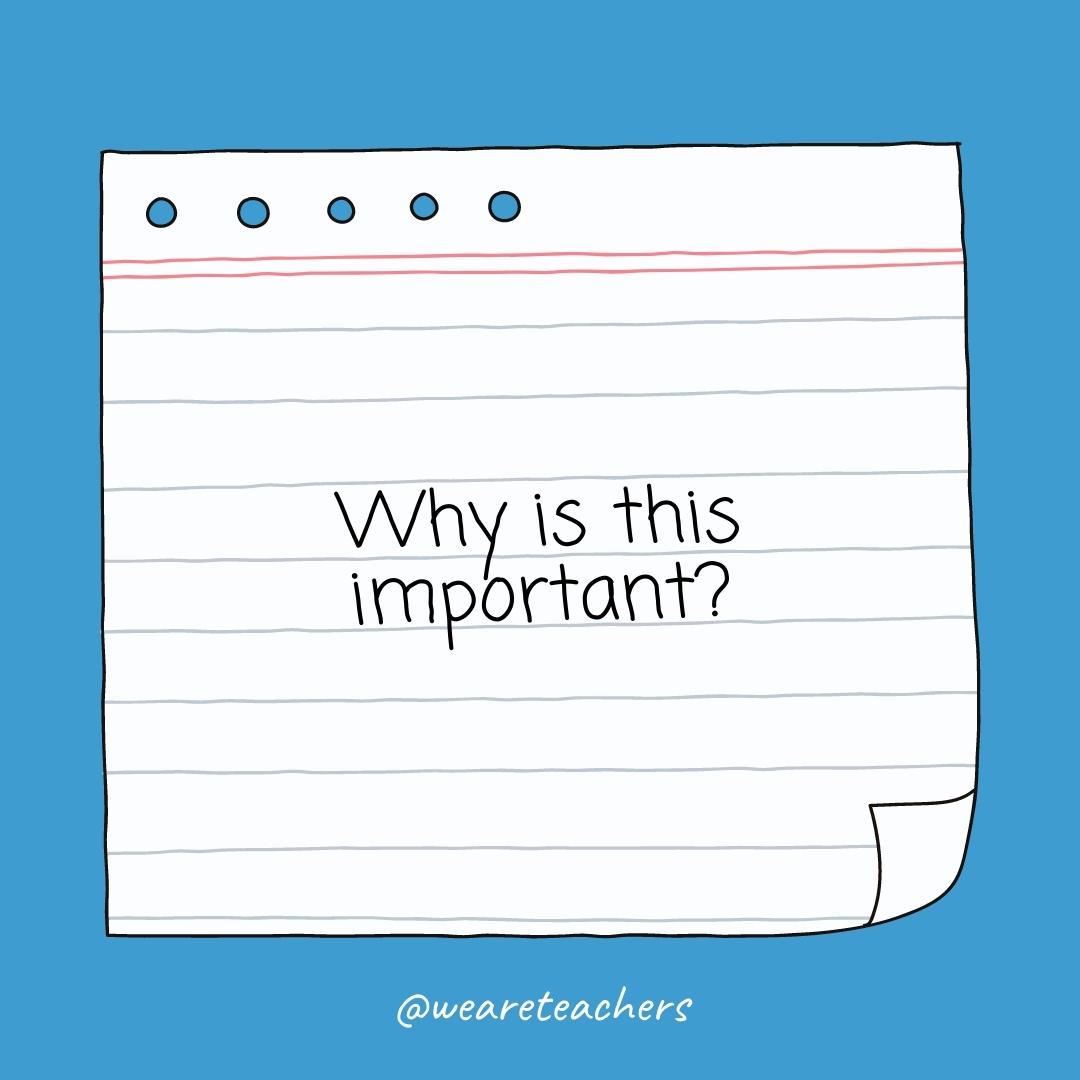
- Did that happen?
- Is it necessary?
- Do you think I (he, she, they) asked that question?
- Is that answer the best one?
- Do we need this today?
“How” Critical Thinking Questions
Use these questions to consider how things happen and whether change is possible.
- Do we know this is true?
- Does the language used affect the story?
- Would you solve … ?
- Is this different from other situations?
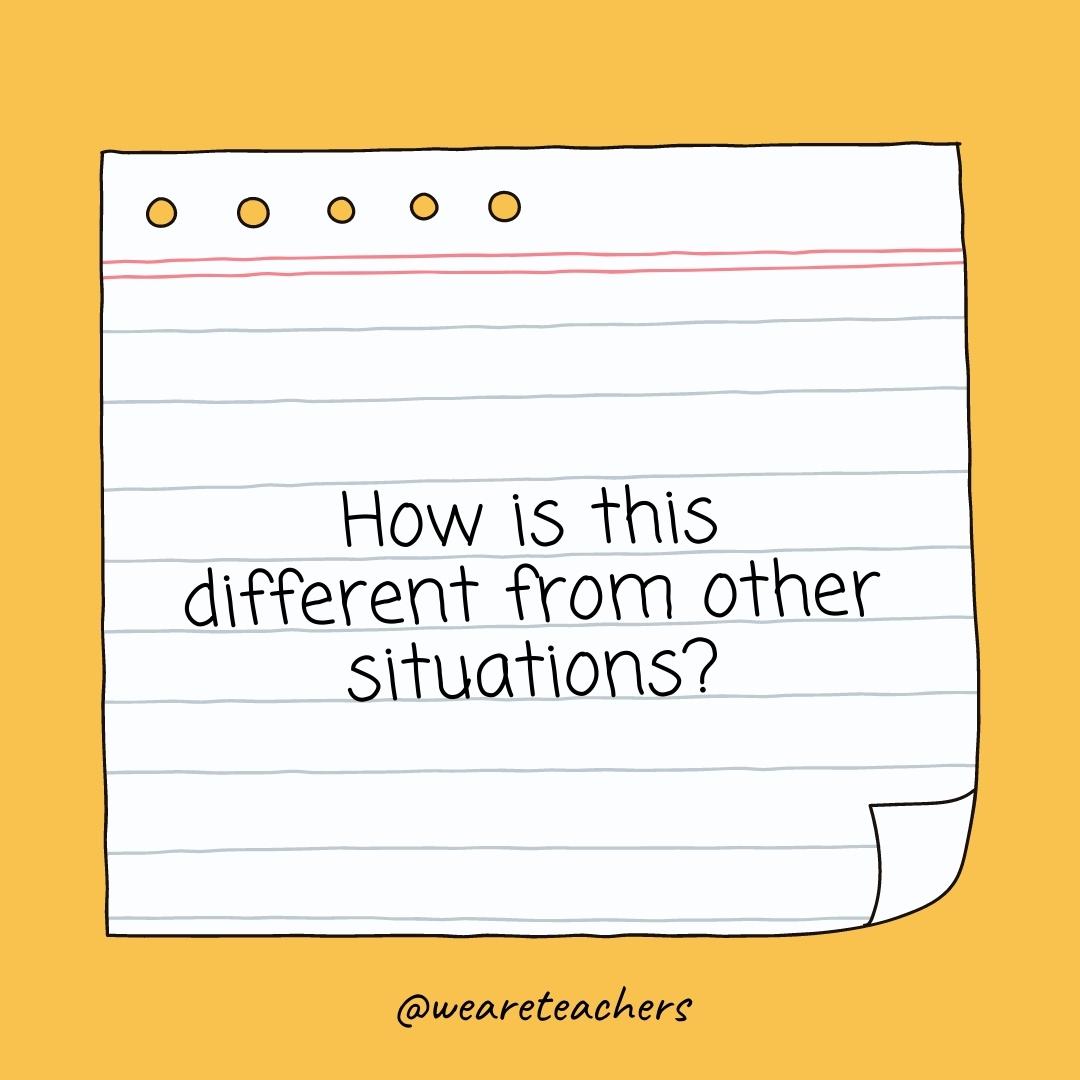
- Is this similar to … ?
- Would you use … ?
- Does the location affect the story?
- Could the story have ended differently?
- Does this work?
- Could this be harmful?
- Does this connect with what I already know?
- Else could this have been handled?
- Should they have responded?
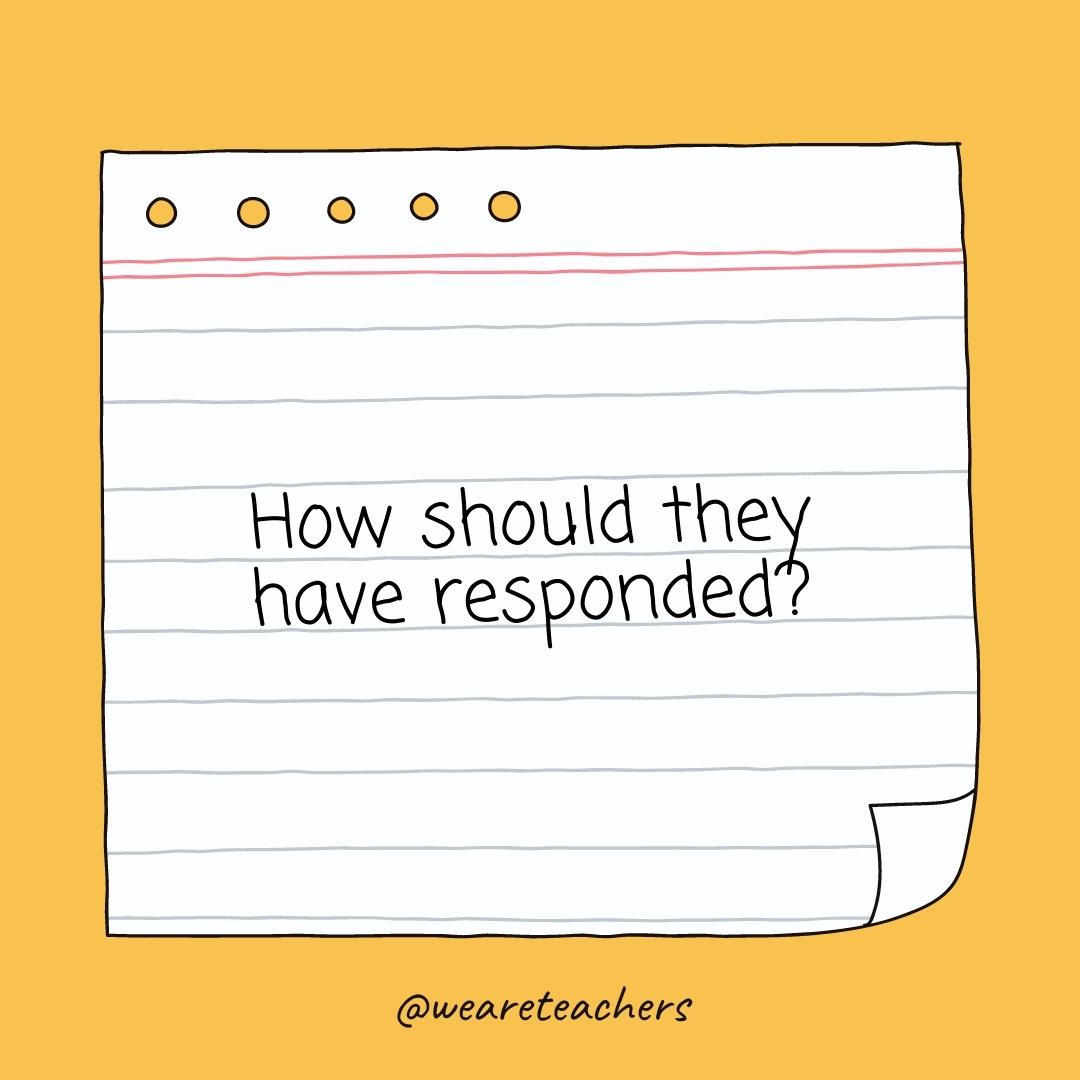
- Would you feel about … ?
- Does this change the outcome?
- Did you make that decision?
- Does this benefit you/others?
- Does this hurt you/others?
- Could this problem be avoided?
More Critical Thinking Questions
Here are more questions to help probe further and deepen understanding.
- Can you give me an example?
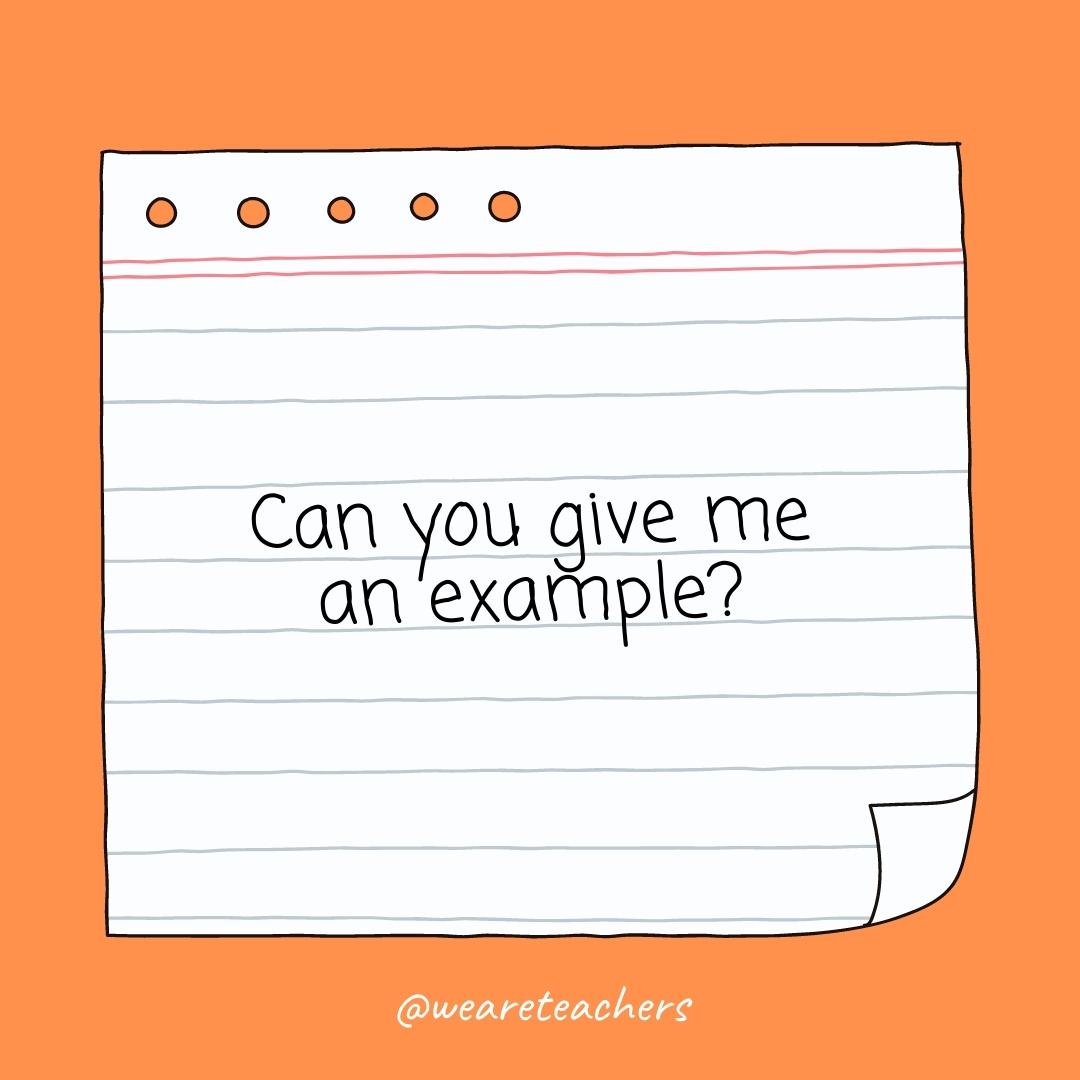
- Do you agree with … ?
- Can you compare this with … ?
- Can you defend the actions of … ?
- Could this be interpreted differently?
- Is the narrator reliable?
- Does it seem too good to be true?
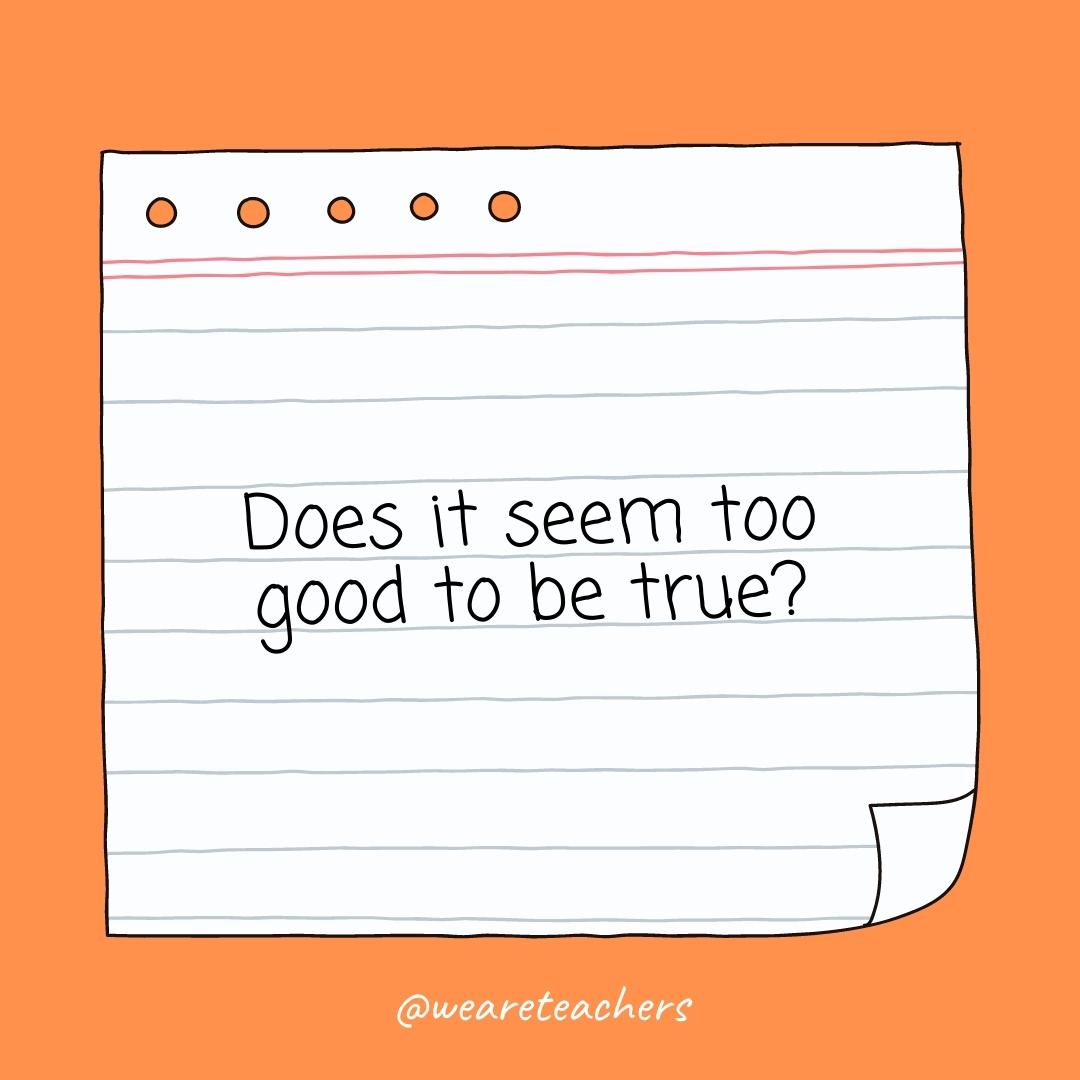
- Is ______ a fact or an opinion?
What are your favorite critical thinking questions? Come exchange ideas on the WeAreTeachers HELPLINE group on Facebook .
Plus, check out 10 tips for teaching kids to be awesome critical thinkers ., you might also like.
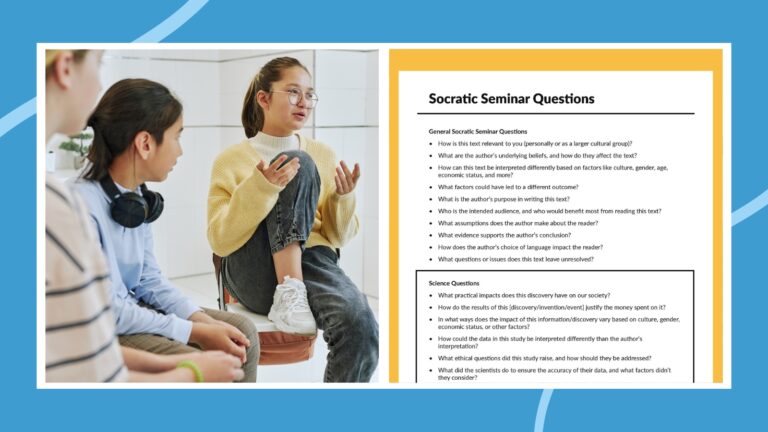
Socratic Seminar: Step-by-Step Guide and Questions (Free Printable)
Here's how to use this guided discussion strategy. Continue Reading
Copyright © 2024. All rights reserved. 5335 Gate Parkway, Jacksonville, FL 32256

- Character Traits
- Compare and Contrast
- Read Alouds
- Point of View
- Reading Response Ideas
- Summarizing
- Text Features
- Text Structures
- Find the Fib
- Reusable Ideas
- Writing Ideas
- Opinion Writing Ideas
- Monster Ideas
- TPT Resources
- Disclosure Policy
- Dollar Deals
- Lifetime Access
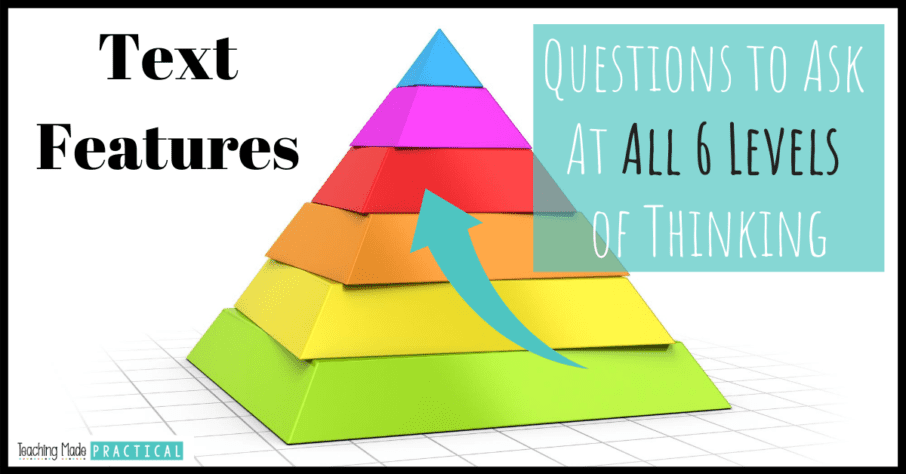
Higher Order Questions for Your Text Feature Lessons
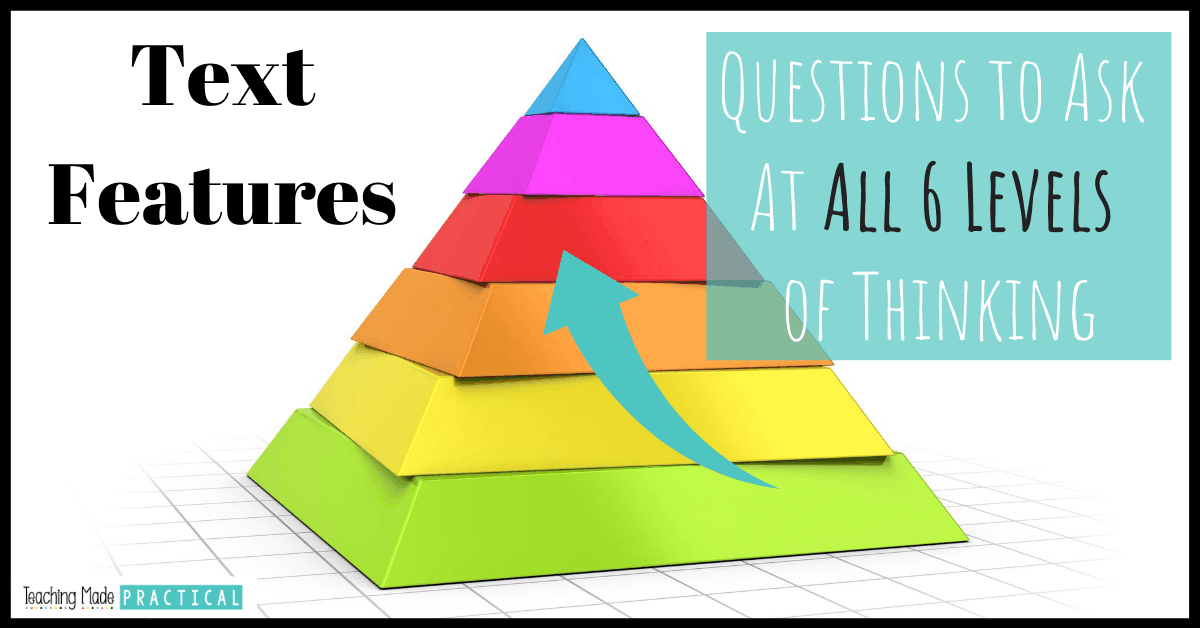
When we question our students about text features, we often focus too much on having students identify different nonfiction text features. While this is essential, it is equally important to get our 3rd, 4th, and 5th grade students thinking more deeply about text features - moving past knowledge and recall questions and into more higher order thinking questions.
Below, find text feature questions you can include in your upper elementary lesson plans for each of the levels of Bloom's Taxonomy. You'll find a free pdf printable of these questions at the bottom of the webpage.
Knowledge Questions
- List all of the text features you found on this page.
- Circle the heading.
- Describe the diagram.
- Draw an example of bold letters.
- Explain where you would find the table of contents of a book.
- Point at the bullet points on this page.
Comprehension Questions
- Explain what a table is in your own words.
- How are a photograph and an illustration different?
- How are captions and labels alike?
- Which text feature best supports the main idea of this paragraph?
- What text feature should you use to figure out the meaning of a word: an index or a glossary? Why?
- Based on the text features in this book, what do you think the book will be about?
Use this free text features chart to help your students learn about the purposes of different nonfiction text features.
Application Questions
- How could you use the title or headings of this book to predict the main idea?
- In what other situations would bold letters be useful?
- What caption would you write for this photograph?
- What text features would you include if you were writing an article on basketball?
- Organize the information in this paragraph into a table or chart.
- Write an appropriate heading for this paragraph.

Want to make your lesson planning even easier? Find everything you need to teach nonfiction text features in this Text Features Bundle.
There are posters, task cards, no prep activities, reading passages, and more to help your students have a deep and thorough understanding of text features and their purposes.
Analysis Questions
- How do the text features on this page relate to each other?
- If you were asked to divide the text features on this page into 2 groups, how would you categorize them?
- What inference can you make about this book based on its text features?
- How do the text features on this page relate to the text?
- Compare and contrast two of the text features on this page.
- Explain the different parts of this diagram or chart. What text features are included within the diagram or chart?
Evaluation Questions
- Which text feature was most useful in helping you understand the text? Why?
- Which text feature was least helpful to you in understanding the text? Why?
- Where in the text could the author have added a table, chart, or diagram?
- Which text feature do you think is the most important to nonfiction books? Why?
- Why do you think the author chose to add this text feature?
- Which text feature did the author use most effectively? Defend your reasoning.
Synthesis Questions
- Write a nonfiction article that includes at least 6 different text features.
- Create an additional text feature for this book.
- How would this book have been different if the author hadn't included any photographs or illustrations?
- Choose one of the text features on the page and write your own paragraph to support the text feature.
- What text feature could be added to help you understand the text better?
- How would the book have been different if the author had not included any headings or titles?
Download a free pdf version of these questions here: Text Feature Questions for Higher Level Thinking
You. might also like these other text feature ideas and activities or these other questions for higher level thinking in upper elementary.
Get Another Text Feature Freebie

A no prep resource to help your students learn the purposes of the most common text features!
Comments 10
I love those sub plans. They are ideal. Do you have any for Non-Fiction?
I don’t have any nonfiction sub plans. I like that idea, however – I might look into creating some in the future.
Thank you for these resources. They have helped me a lot. These are very interactive and helps my students to use their higher level thinking skills.
I’m so glad you have found some helpful ideas!
Thanks for this resource. Check the PDFs heading. It says Character Traits.
Thanks! It has been updated.
I love this free resource but the text features PDF says character traits at the top.
Thanks for pointing that out! I’ll update that.
Check the spelling error.. evaluation. I love this and plan to share it.
Thanks for pointing that out! I plan on turning this information into a pdf document so that its easier to print, so come back and check for that!
Leave a Reply Cancel reply
You must be logged in to post a comment.
Weather: A Journey in Nonfiction
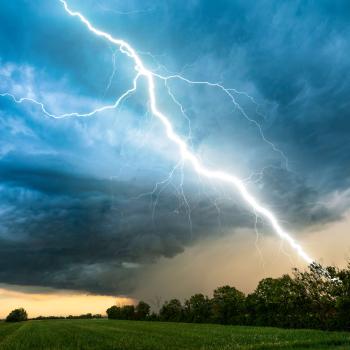
- Resources & Preparation
- Instructional Plan
- Related Resources
This research project is designed for primary students to engage in nonfiction text, in both print and digital format. Students begin by formulating questions on a subject (in this case, weather), then classify questions into topic areas. After grouping students by topic areas and assigning a question previously generated, students engage in nonfiction text to answer the question. Combining question with answer, students construct sentences that are then combined with others in their topic group to form a "report" (paragraph length). The group then creates an illustration to reflect the topic and publishes it in the chosen format (print or digital).
From Theory to Practice
- Children gather experience and knowledge from both types of texts (narrative and expository) and we should expose them to both in our literacy programs.
- Teachers have a responsibility to motivate children to read all types of texts.
- By listening to nonfiction and talking about it, children will gain respect for expository language as well as learn to emulate the best examples in their own writing.
- Teachers need to look for opportunities to incorporate the literature of fact into literacy programs, not as texts to learn but as rich, meaningful experiences.
Common Core Standards
This resource has been aligned to the Common Core State Standards for states in which they have been adopted. If a state does not appear in the drop-down, CCSS alignments are forthcoming.
State Standards
This lesson has been aligned to standards in the following states. If a state does not appear in the drop-down, standard alignments are not currently available for that state.
NCTE/IRA National Standards for the English Language Arts
- 1. Students read a wide range of print and nonprint texts to build an understanding of texts, of themselves, and of the cultures of the United States and the world; to acquire new information; to respond to the needs and demands of society and the workplace; and for personal fulfillment. Among these texts are fiction and nonfiction, classic and contemporary works.
- 3. Students apply a wide range of strategies to comprehend, interpret, evaluate, and appreciate texts. They draw on their prior experience, their interactions with other readers and writers, their knowledge of word meaning and of other texts, their word identification strategies, and their understanding of textual features (e.g., sound-letter correspondence, sentence structure, context, graphics).
- 6. Students apply knowledge of language structure, language conventions (e.g., spelling and punctuation), media techniques, figurative language, and genre to create, critique, and discuss print and nonprint texts.
- 7. Students conduct research on issues and interests by generating ideas and questions, and by posing problems. They gather, evaluate, and synthesize data from a variety of sources (e.g., print and nonprint texts, artifacts, people) to communicate their discoveries in ways that suit their purpose and audience.
- 8. Students use a variety of technological and information resources (e.g., libraries, databases, computer networks, video) to gather and synthesize information and to create and communicate knowledge.
Materials and Technology
- The Cloud Book by Tomie De Paola (Holiday House, 1975)
- I Like Weather by Aileen Fisher (Crowell, 1963)
- On the Same Day in March by Marilyn Singer (HarperCollins, 2000)
- Weather. Smart Apple Media
- Fun with Science. Warwick Press
- Let's Read and Find Out Science. HarperCollins
- Magic School Bus . Scholastic
- Word Processor: Any standard program or ClarisWorks for Kids (aimed at primary students)
- Illustrator: Kid Pix Deluxe, ClarisWorks for Kids, HyperStudio
- Multimedia: Kid Pix Deluxe, HyperStudio, PowerPoint
Assessment Summary
Preparation
Work with the school librarian and the technical assistant to gather materials and bookmark webpages for the research phase of this project. Work with the technical assistant to determine what software is available and appropriate for your students.
Student Objectives
Students will
- Formulate logical questions
- Utilize print and digital texts to locate information
- Comprehend nonfiction text to locate information
- Contribute to a group project
- Add an element to a group illustration that relates to the topic
- Reflect on their learning process for the project
Instruction and Activities
Session 1 - Explore weather Introduce the topic by reading fiction books about weather (see Materials list-fiction). Have students generate a K-W-L chart about the topic of weather. As a class, list questions generated by students, then group questions by topics. Possible topics: storms, rain, snow, clouds, wind, ice, floods, hurricanes, lightning, tornadoes, sun Session 2 - Formulate questions Put students into small groups and assign each group one of the topics that was generated in Session 1. Distribute questions by topic to the groups. Each student within the group should write down one of the questions generated on a notecard. Help students formulate a question that can be researched and answered by either books or Internet sites. Ideally, each student will have an individual question related to the group topic. Session 3 - Research Have an assortment of nonfiction books and bookmarked websites (see Web resources and Materials-nonfiction) available for students. As students locate the answer to their question, they should record it on their notecards. Also utilize some type of bibliographic format to create awareness of references and copyright for students. (Suggestion: Title, Author, Date OR Title of website, URL address, date), Have students record this information on the notecard also. Session 4 - Create report Each student's task during this session is to combine his or her question and notes into one sentence. (Example: What is a storm? Disturbance in weather = A storm is a disturbance in the weather.) Sentences from each student are then combined to create a "report" on the group topic. This sentence product can be handwritten or typed using a word processing program. Session 5 - Illustrate topic Have students work as a group to create an illustration for their report. Emphasis is on consensus as students must plan and agree to what element of the picture each student wishes to contribute. A low-tech option is to use traditional art methods that can be scanned into digital form. A high-tech option can be accomplished utilizing an illustration program such as Kid Pix, or ClarisWorks for Kids. Session 6 - Present findings Three possibilities are suggested ranging from low- to high-tech.
- Combine emergent and beginning readers with independent readers to provide opportunities for students to help each other (i.e., first- and second-grade student combinations).
- Consider doing only some of the lessons. Sessions 1-3, although building upon each other, can be delivered independently. Adjust the technology level, as you feel comfortable.
- Create a website as a final product.
Student Assessment / Reflections
Utilize the Assessment Summary handout provided. Summary includes checklist for Session 2, rubric for Sessions 3 and 4, and a journal response for Sessions 5 and 6.
- Calendar Activities
- Lesson Plans
- Student Interactives
- Strategy Guides
This tool allows students to create an online K-W-L chart. Saving capability makes it easy for them to start the chart before reading and then return to it to reflect on what they learned.
Add new comment
- Print this resource
Explore Resources by Grade
- Kindergarten K

IMAGES
VIDEO
COMMENTS
Setting: Consider the setting of a creative nonfiction story. Where is the story set? How does the author describe the setting? At what point in the story do they describe the setting? Which senses are used when describing the setting (sight, sound, smell, touch, taste, feeling)?
critical thinking questions: What details in the story contribute to its eerie atmosphere or mood? Or what figurative language devices does Neil Gaiman use to create a sense of suspense in the story?
Students can use these critical thinking questions with fiction or nonfiction texts. They’re also useful when discussing important issues or trying to understand others’ motivations in general.
Find everything you need to teach nonfiction text features in this Text Features Bundle. There are posters, task cards, no prep activities, reading passages, and more to help your students have a deep and thorough understanding of text features and their purposes.
Lesson #1: Define and Understand Perspective. A simple entry into teaching readers to understand and define perspective is to begin with a “non-academic” shared experience. Start by designing an experience that sets up students to discuss the visual component of perspective - point of view or vantage point.
Critical literacy begins in being able to decode a text and then analyze it for meaning, implicit and explicit themes, and the relationship of a text to a given perspective, author’s purpose, and related text and media.
A Cheat Sheet For Critical Thinking. In short, critical thinking is more than understanding something — it involves evaluation, critiquing, and a depth of knowledge that surpasses the subject itself and expands outward. It requires problem-solving, creativity, rationalization, and a refusal to accept things at face value.
The questions with these texts are designed to measure critical thinking and comprehension skills, such as summarizing information, drawing conclusions, and evaluating an author’s purpose and point of view.
This research project is designed for primary students to engage in nonfiction text, in both print and digital format. Students begin by formulating questions on a subject (in this case, weather), then classify questions into topic areas.
Below is a short list of questions for you to model thinking aloud as you read and teach students how to identify bias in a text. Whose voice/argument is included? Whose voice/argument is missing?